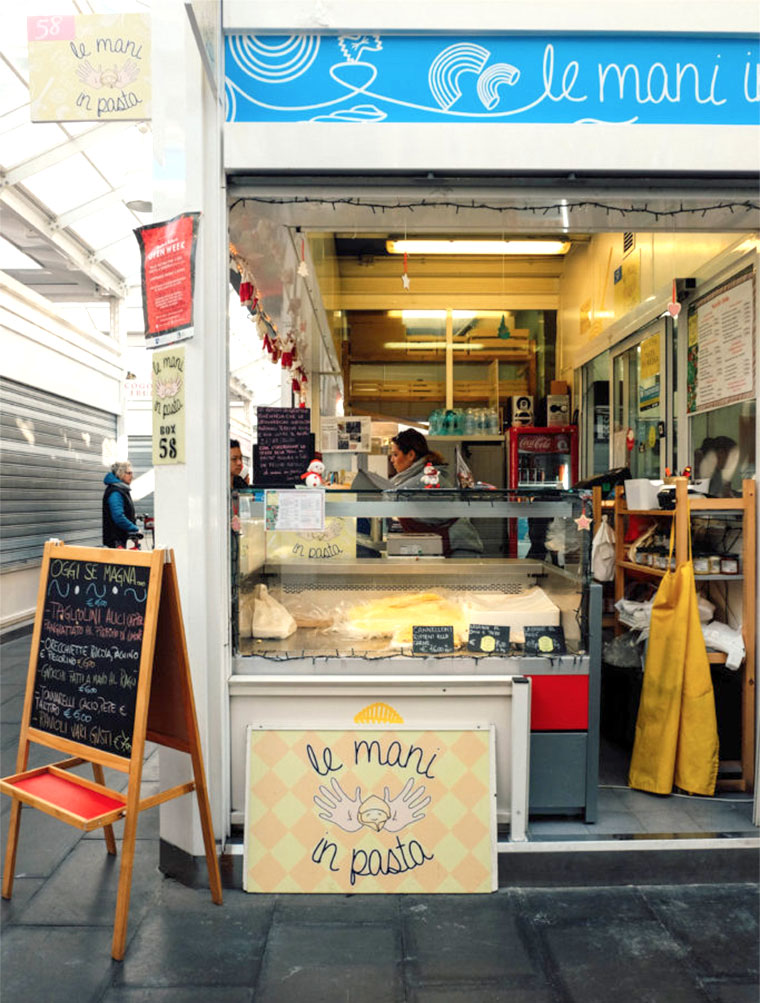If you ever find yourself in need of an espresso, a panino (a sandwich), pane or dolci (bread or sweets), or simply good company and a fun outing, take a stroll along the east side of the Tiber River just south of Trastevere, to the 20th rione of Rome, a quaint little neighborhood called Testaccio. This district is perhaps best known as the home of one of Rome’s oldest markets, one that is traditional yet vibrant, reminiscent of an artist’s paint pallet, with colors bursting from every stand in every corner. Here you will find stands filled with bundles of grapes, clementines, oranges and figs, cured meats hanging from the ceiling, fresh cuts of lamb, pork, beef or even horse, coffee beans, rich, creamy expresso (shots of which, in my opinion, are some of the most potent you could find anywhere in Italy), and the scent of pastries and other baked goods wafting between the stalls. For the majority of customers who browse the hundred-plus stalls for produce, meats and baked goods, shopping at the market is not just a transaction, it is an experience, and is equally as important, if not more, as the quality of the goods that are brought home at the end of each day.

[/caption]
From the Sartor family’s butcher stall to the baked goods from Da Artenio, the people who own these stands have operated in this market space for decades, and their families, for generations. However, the long-standing Mercato di Testaccio has recently transitioned into a new venue at via Galvani and is fittingly now called il Nuovo Mercato di Testaccio (the New Testaccio market). While the old location was dark and a bit dirty—though full of tradition and still much beloved among locals—the new market is bright and airy, with walls painted all in white and a ceiling made of windowpanes to let the sun soak through, bringing more of a modern feel to this decades-old market. The via Galvani location also has outdoor seating available outside the market’s café, making up a small part of the 5000 square feet of space available. The tables here quickly became enviable real estate since a good portion of the shoppers are likely to treat an outing to Testaccio’s market more as a social activity, passing a few hours eating whatever cuisine had their taste buds watering that day, as well as chatting with friends and vendors, watching others barter, and trading town gossip.
Though the change of location was cause for doubt among some veterans of the market, loyal to the traditional location, the move has proved successful. The products offered have retained their quality, and the atmosphere, its old flavor. Since the building is so spacious, it has also allowed old vendors to not only keep the fan-favorite products, but to expand their selection, and to make way for a variety of new vendors and new products. The market boasts much more than food, and includes other goods such as books, pottery, art, clothing, shoes, furniture, home décor—the list could go on—so the odd tourist here or there that may forget their umbrella on the city bus on the way to the Mercato can easily find a replacement, perhaps an individual-sized purple umbrella with a handmade wooden handle. (I’m now quite fond of rainy days—nostalgia for Testaccio sets in whenever I pull out my purple umbrella.)
I mercati rionali, or neighborhood markets, are distinguished by their location, and the unique culture of that particular neighborhood. Testaccio might not be the first place any tourist might think to visit—in fact, one of the first words I used to describe it was scialbo (dull)—but the 20th rione quickly grew on me, and now I love the town’s quaint, hipster, rustic vibe. The district is situated between a number of universities which adds to its increasingly youthful atmosphere, and Testaccio’s market has evolved alongside the district for which it was named, catering to its busy university students (many of whom are international), by offering convenient, ready-made to-go meals. Even while staying up-to-date in today’s fast-paced world, il Nuovo Mercato di Testaccio remembers its roots and remains authentically Roman. The neighborhood of Testaccio itself is antique yet modern, and as serene as it is energetic. Taking a stroll down the piazza, you might see older gentlemen in bowler caps and suspenders walking their dog on a leash, women holding animated conversations as they meet on the corner, or teenagers hanging around outside a coffee or pastry shop. Near the center of the district is a large, modern Catholic church with murals of modern religious art on the far wall above the altar, and further down the street, graffitied walls, busy little restaurants and nightclubs. The market, just like the neighborhood, is a medley of calm and chaotic, modern and traditional. At first, this rione might not look like much, but there is something in the stones and in the air that breathes equal amounts of peace and excitement into the bones of anyone who stays long enough to appreciate its unique culture.




























